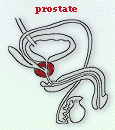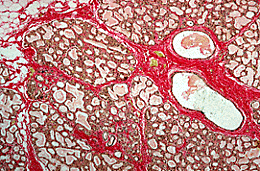SUPPLEMENTARY: 3
Prostate Gland (LP)
|

This medium power picture shows some of the numerous glands which make up the prostate. The individual secretory units are surrounded by abundant smooth muscle and collagen fibres. The glands are arranged in three groups.
1 A small number of mucosal glands lie immediately deep to the epithelium and open directly into the prostatic urethra.
2 A larger group of submucosal glands open via short ducts from the anterior and lateral parts of the gland into the urethral sinuses. With advancing age (from 45 years) the mucosal and submucosal glands normally undergo benign hypertrophy which can cause urinary outflow obstruction.
3 Posteriorly, the main prostatic glands, which make up two thirds of the bulk of the prostate, lie around the periphery of the organ. These are the glands in which malignant change can lead to prostatic carcinoma, which is the second most common cancer in men and the 3rd leading cause of cancer related death.

This section shows that the secretory units vary in size and shape, some are large and irregular, some are narrow, branching tubules. The collagen of the connective tissue septa stains red in this section.
The epithelium of the glands may be greatly folded (these folds disappear with age so that secretory units in the prostate of older men have a more regular form). The height of the epithelial cells lining the glands is variable - it may be low cuboidal, but in most secretory units it is either simple columnar or pseudo-stratified columnar.
The secretion produced and stored by the glandcan be seen in the lumen of the secretory units. In older men the secretion may become calcified as prostatic calculi.
At ejaculation, spermatozoa are propelled by powerful muscular contractions from the tail of the epididymis, along the length of the vasa deferentia to the ampullae where the secretion of the seminal vesicles is mixed with the sperm. This sperm suspension then passes rapidly through the ejaculatory ducts in the substance of the prostate where the prostatic secretions are released into the urethral sinuses. Reflex contraction of the internal sphincter prevents the ejaculate from passing superiorly into the bladder; therefore the semen passes along the membranous and penile urethra and is ejaculated.
Tutorial Navigator:

